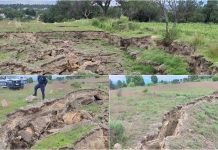A new picture from USGS shows that giant earth cracks are forming presently at Kilauea.
So what are these booming ground cracks and what do they mean for the ongoing eruption.

These creepy ground cracks and settling are commonly associated with volcanic activity. Both generally occur near active or recently active volcanic vents as the result of shallow underground movement of magma.

The beginning of an eruption at a new site is preceded by cracking of the ground as magma is forcefully injected into the area.
This earth crack is located in the sulfur banks. You can see the smoke rising from the ground. Amazingly, trees, flowers and grasses grow right next to this:
The cracks may be as much as 6 feet wide and over a mile long; typically they form within a period of hours.

These volcanic ground cracks at the base of the cone propagated uprift and were accompanied by booming noises:

Ground settling may occur near a vent at the end of an eruption as magma drains away from beneath the vent area.
This process produces both small depressions and large collapse features, such as the pit craters and summit calderas of Kilauea and Mauna Loa. In either case, the subsidence may be gradual or abrupt.
Now a video of a cracked lava flow you can walk through in Oregon:
The hazard presented by ground cracks and settling associated with eruptions is usually limited to areas near the active vent and thus is overshadowed by the hazard posed by lava flows. And this means, there is an ACTIVE AREA… SO IT’S NOT THE END YET!
Man-made structures that escape other damage from an eruption, however, can be damaged or destroyed by cracking, tilting, or settling of the ground beneath them.
Ground cracks will remain after the eruption is over and can pose a threat to unwary people and animals if the cracks are obscured by heavy vegetation.
Did you hear some loud booming noises near the ongoing Kilauea ground cracks? Do you think it was these cracks forming?












